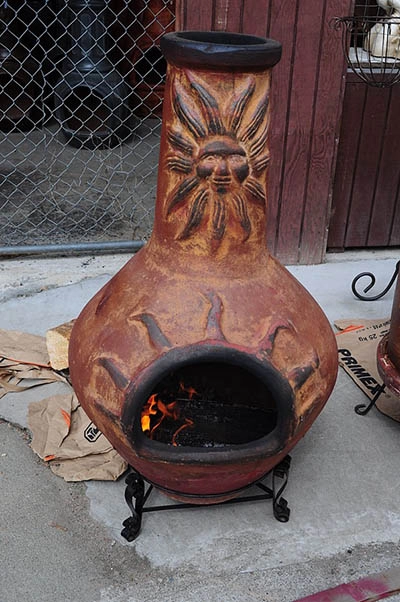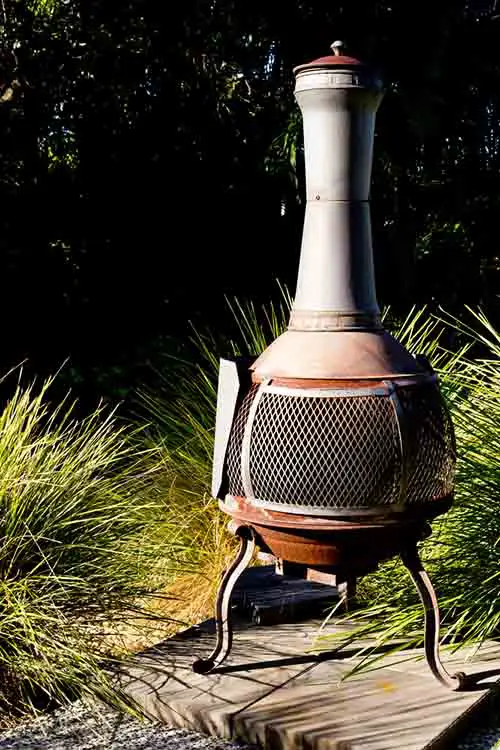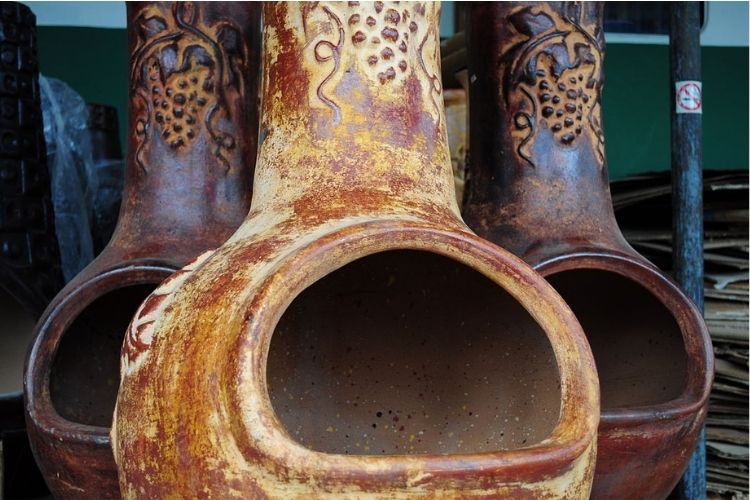With the summer upon us, there’s nothing quite like having some pleasant outdoor fun by cozying around the dim evening light around the glow of a lit chimenea.
Great for creating a calm atmosphere, keeping you warm, and cooking some tasty meals, a chimenea is a great choice for your patio or garden.
What Is a Chimenea?

A chimenea is a hand-decorated fireplace with a pot-belly-shaped base that rises to a vertical chimney. You can find them in home decor or patio stores, marketplaces, and they are popular in destinations including Mexico and Western states like Arizona and California.
They have been around for hundreds of years and have become a popular item and a must-have in many people’s backyards. They were originally made to be functional and have been used for centuries, mainly for cooking and heating.
However, many people use them as garden art. They are unique and have a beautiful aesthetic appeal to gardens and patios and give off an authentic southwestern or rustic look during the day and add a lot of beauty and character to your backyard when you build or light fires in them in the evening.
Unlike the wider, more open fire pit, a chimenea is more contained. After igniting, it can reach full burn in about 15 minutes and give off a lot of heat. The fire can be controlled like any wood-burning outdoor fireplace or fire pit.
The History of Chimeneas
The origin of chimeneas can be traced to Spain and its influence on Mexico. Historically, they were made out of fired terracotta clay and designed with a wide-bottom vase design. The design of the classic style has a round, squat belly base, a narrow vertical chimney through where smoke escapes, a wide round mouth on the side for the fire pit through which you place firewood, and a metal base inside the base on which the firewood sits on.
The traditional chimenea was mostly used indoors, usually in the center of the home with an opening in the roof or near an open window to allow smoke to escape. It was a daily necessity in the home. Its primary purpose was cooking and heating. The first use of traditionally designed chimeneas can be traced to 400 years ago.
While they are traditionally made from terracotta clay, modern-day high-performing models are made from different materials. These materials include grog, cast iron, ceramics, cast aluminum, stainless steel, and even brass. Additionally, in the modern home, chimeneas are often used as garden art and lit when entertaining guests in a backyard setting in the evening.
4 Types of Chimeneas

There are different types of chimeneas based on the type of material they are made from:
1. Terracotta Chimenea
The terracotta chimenea is the original design and offers a classic Mexican-inspired look. These make a great earthy addition to any themed garden or backyard.
They are the most prone to damage, and when not handled carefully, they can break or crack.
2. Ceramic Chimenea
Ceramic chimeneas are great for outdoor decoration. They can withstand extreme temperatures and, with proper maintenance, can last many years.
3. Cast Iron Chimenea
A chimenea constructed with cast iron is stronger and lower maintenance than other materials. Cast iron is more resistant to damage, is better suited for climates with a wide temperature range, and can produce high heat levels for many years.
The cast-iron design comes in different sizes and styles and offers you various options to choose from. The only downside of cast iron chimeneas is that since they burn very hot, you need to be careful when touching them, and they are heavy, making them extremely hard to move.
4. Steel Chimenea
Steel chimeneas are lighter than their cast iron counterparts. Although they do a great job at radiating heat, they don’t match the full flame power of cast iron.
What Can You Burn in a Chimenea Fireplace?
Chimeneas are designed to burn wood. The best option is to use hardwood, which is ideal for burning for heat and long-lasting fires. Aromatic woods like cedar, mesquite, hickory, and pinon are popular choices. However, if you’re planning to use yours for cooking, charcoal is ideal.
You should never use gasoline, lighter fluid, or any other flammable liquid on your chimenea. These liquids can cause it to heat up too fast and result in dangerous explosions that can cause it to break or crack. Instead, you can kindle the fire using newspapers.
What To Look For When Buying a Chimenea?
If you’re planning on buying a chimenea for the first time, you’re probably debating on exactly what kind of you should buy. It might be easy to get carried away by the lovely exterior decorations you’ve been eying online and forget the functionality of it all. So before investing in a chimenea, you should consider the following factors:
- Material: While terracotta clay gives a traditional rustic appeal, they aren’t the best choice for an all-year-round fireplace if you’re not planning on covering them when it rains or during the winter. On the other hand, cast iron chimeneas would serve you throughout the year without much maintenance.
- Size: Is there enough space in the fire pit to fit the standard-size firewood? Can it produce the level of heat you need? The heat output of a chimenea increases with size.
- Your location: Do you live in an area that bans wood-burning fireplaces both indoors and outdoors? If so, you can opt for a chimenea that burns on gas or liquid propane.
Where Should You Put Your Chiminea?
Place it in an entertainment space outside or where it can be visible from the inside of your house. It should also be located such that the predominant wind patterns carry the smoke away from your house.
For the chimney to function properly, it needs to be set up straight and vertical. This will ensure sooting occurs inside the fire chamber. It should also be placed on top of fire-save paving surfaces like concrete, stone patios, and brick surfaces.
Caring Tips and Maintenance for Your Chiminea
Care and maintenance of your chimenea will largely depend on the type of material it’s made from. General maintenance tips include:-
- Reapply heat resistant sealant on the outside at least once a month to protect it from water and moisture that can soften the clay and cause the iron to rust
- Store or cover during cold and wet seasons
- Place sand or gravel at the bottom of the fire pit to help clean out ashes
- Allow the fire to burn out completely, and don’t use water to extinguish the fire
- Repair cracks as soon as they appear
- Allow it to dry out if it becomes wet
- Keep away from combustible materials
- Handle with care to prevent cracks or dents
- Don’t build large fires
- Don’t heat too quickly
Unlike the conventional fireplaces, chimeneas are convenient to use, are portable, can be used anywhere, and add an aesthetic appeal to your garden.
Featured Image Credit: Joe Mabel Via Creative Commons

